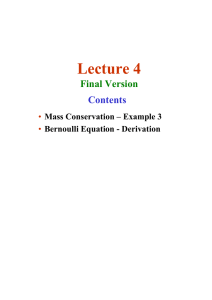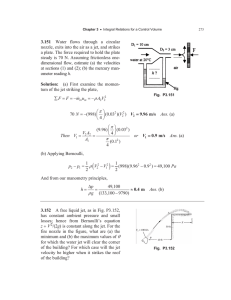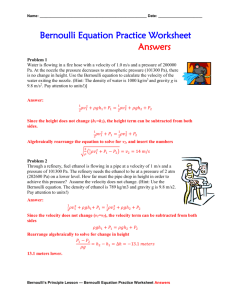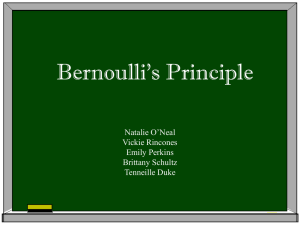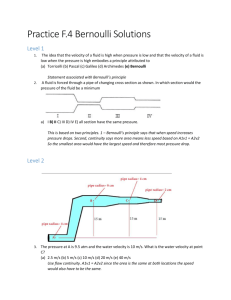Lecture 4 Preliminary Version Contents •
advertisement
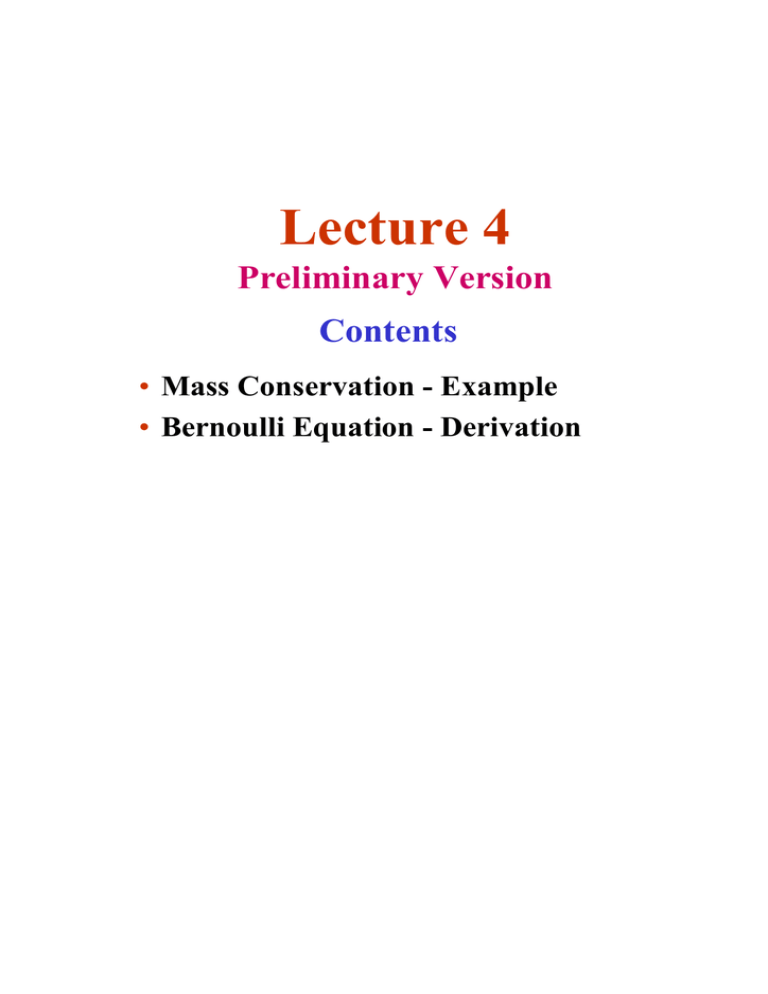
Lecture 4 Preliminary Version Contents • Mass Conservation - Example • Bernoulli Equation - Derivation What Did We Do In Last Lecture? Control Volume / Control Surface Classification of Forces • Body Force vs Surface Force • Static Force vs Dynamic Force Reynolds Number Re = UL ν • Non-dimensional number • Ratio of inertia forces and viscous forces What Did We Do In Last Lecture? Streamlines / Stream Tubes Laminar / Turbulent Flow What Did We Do In Last Lecture? Other Non-dimensional Numbers Conservation of Mass /Continuity Equation ∑ρ Q = 0 Example 3: • A cylindrical open-top tank with height 1.3 m and a radius of 0.5m is filled with water. Water drains from a hole with diameter 0.04m near bottom. How long does it take until water level has dropped to a height of 0.4 m. The average outflow velocity is given by... V = 2gh h0 = 1.3 m h2 = 0.4 m rtank = 0.5 m Solution: • Conservation of mass for a control volume CV requires... • • min − mout dm cv = dt Continued ... • However, here no mass enters the CV ... • • min = 0 • mout dm cv = dt (1) Mass flow rate out is ... • mout = (ρ V A jet )out • With given outflow velocity V one gets... • mout = (ρ 2 g h A jet )out (2) with 2 A jet = π r jet • Mass of water in tank at any time is ... mcv = ρ Vol. = ρ Atan k h (3) with 2 Atank = π rtank • Now substitute (2) and (3) into (1). This gives ... Continued ... • After substituting in we have ... − ρ 2 g h A jet = d ( ρ Atank h ) dt With areas of tank an jet 2 A jet = π r jet −ρ 2 g hπ 2 Atank = π rtank 2 r jet ( 2 d ρ π rtank h = dt Get constants out of the d(...)/dt 2 2 − ρ 2 g h π r jet = ρ π rtank 2 2 − 2 g h rjet = rtank dh dt dh dt ) Continued ... • Rearranging last equation from previous slide gives ... 2 rtank dt = − 2 r jet 2 rtank dt = − 2 r jet • dh 2gh 1 dh 2g h Integrate ... t h2 2 rtank dt = − 2 r jet 0 h ∫ ∫ 1 dh 2g h 0 On right-hand side get constants in front of integral t ∫ dt = − 0 2 rtank 2 r jet 1 2g h2 ∫ h0 dh h Continued ... • Carry out integration of integral on previosu slide ... t ∫ dt = − 0 2 rtank 2 r jet 2 rtank t=− 2 r jet t= • 2 rtank 2 r jet 1 2g 1 2g h2 ∫ h0 ⎡ ⎢⎣2 h 1 dh h 2⎤ h2 ⎥⎦ h 0 1 ⎞ 2 ⎛ 12 ⎜⎜ h0 − h2 2 ⎟⎟ 2g⎝ ⎠ Substituting in given values yields ... (0.5 m )2 2 ( 1.3 m − 0.4 m ) t= 2 2 (0.02 m ) 2 ⋅ 9.81 m/s = 143.3 s = 2 mins 23.3 s Note: We neglected viscosity. Thus, in reality actual time for tank to drain will be somewhat longer. Derivation of Bernoulli Equation Introductory Remarks • • Previously considered pressures in static fluids (i.e. hydrostatic pressure). Learnt that: “The pressure at any two points at the same level in a body of fluid AT REST will be the same ” • Will now look at fluids in motion. Will find that pressure at same level in a body of fluid also depends on flow velocity. What we will find is ... • Velocity decreases, satisfy mass • conservation Velocity decrease accompanied by pressure increase. High Flow Velocity Low Pressure Low Flow Velocity High Pressure Continued... Analogy of ... • Low(Minimum) Velocity • High (Max.) Potential Energy • Velocity Increases • Potential Energy Decreases • Maximum Velocity • Minimum Potential Energy • Velocity Decreases • Potential Energy Increases • Low (Min.) Velocity • High (Max.) Potential Energy … Bernoulli Equation expresses … CONSERVATION OF ENERGY FOR FLOW! Continued... • Bernoulli Equation can be derived from what is known as the Steady-Flow Energy Equation (SFEE). • While derivation via SFEE may make it more obvious why Bernoulli equation represents conservation of energy we will however, follow the derivation of Douglas et al. (2001, Fluid Mech. 4th Ed., Prentice Hall, p. 141-141) that is reproduced in your Tech. Sci. 2 book. Continued... • • • Consider streamtube surrounding a streamline shown below. Cross-sectional area at entrance and exit small enough that flow velocities constant over cross-sections. Assume that fluid is inviscid. D δs A C θ A v p pside B A + δA v + δv p + δp mg z + δz z • Mass per unit time flowing = • Momentum per unit time = ρ Av (ρ A v) v Rate of increase of momentum from AB to CD = ( ρ A v ) (v + δv ) − ( ρ A v ) v (1) = ( ρ A v ) δv Continued... Forces acting to produce this increase of momentum in direction of motion are: cosθ = δz δs • Force due to p in direction of motion = • Force due to ( p + δp )opposing motion = • Force due to pside producing a component motion in the direction of motion = pside δA • Force due to m g producing a component opposing motion = m g cosθ pA ( p + δp ) ( A + δ A ) (2) Resultant Force in direction of motion = p A − ( p + δp ) ( A + δA) + pside δA − m g cosθ Continued... • Value of pside will vary from p at AB to ( p + δp ) at CD and can be taken as: pside = p + k δp where k is a fraction. • Weight of element: 1 ⎞ ⎛ mg = ρ g × Volume = ρ g ⎜ A + δA ⎟ δs 2 ⎠ ⎝ • Component of weight in direction of element: δz 1 ⎞ ⎛ mg cosθ = ρ g ⎜ A + δA ⎟ δs ⋅ δs 2 ⎠ ⎝ • (3) Multiplying out Eq. (2) from previous slide and substitute in Eq. (3): Resultant Force in direction of motion = − p δA − Aδp − δpδA + pδA + kδp ⋅ δA 1 ⎞ δz ⎛ − ρ g ⎜ A + δ A ⎟ δs ⋅ 2 ⎠ δs ⎝ Continued... • Two terms cancel each other out and we neglect small terms or order δ2 Resultant Force in direction of motion = − p δA − Aδp − δpδA + pδA + kδp ⋅ δA 1 ⎞ δz ⎛ − ρ g ⎜ A + δ A ⎟ δs ⋅ 2 ⎠ δs ⎝ Continued... • Two terms cancel each other out and we further neglect small terms or order δ2 Resultant Force in direction of motion = − p δA − Aδp − δpδA + pδA + kδp ⋅ δA 1 ⎞ δz ⎛ − ρ g ⎜ A + δ A ⎟ δs ⋅ 2 ⎠ δs ⎝ Continued... • So, what is left is…. Resultant Force in direction of motion = − Aδp − ρ g A δz (4) Continued... • Applying Newton’s second law, i.e. equating Eq. (4) with Eq. (1) Resultant Force in direction of motion = − Aδ p − ρ g A δ z (4) Rate of increase of momentum from AB to CD = ( ρ A v ) δv (1) ( ρ A v ) δ v = − Aδ p − ρ g A δ z • Divide by ρ A δs … δv δz 1 δp +v + g =0 ρ δs δs δs • Let δs → 0 … Continued... • Limit yields ... EULER’s EQUATION 1 dp dz dv +v + g =0 ρ ds ds ds • The • (5) equation states, in differential form, relationship between pressure, density and elevation along a streamline for steady flow. It cannot be integrated until relation between density and pressure is known! Continued... HOWEVER... • For incompressible flow, i.e. for flow with constant density... 1 ρ dp + v dv + g dz = 0 ∫ ρ dp + ∫ v dv + ∫ g dz = const. 1 dp + v dv + g dz = const. ∫ ∫ ∫ ρ 1 1 1 2 p + v + g z = const. ρ 2 • Terms mass. (6) in Eq. (6) represent energy per unit Continued... • Dividing Eq. (5) through by g gives: BERNOULLI EQUATION p v2 + + z = const. = H ρ g 2g • Here • the terms represent energy per unit weight. All terms are all in units of (Length). • Alternative form is... Alternative Form p+ • Here ρ 2 v 2 + ρ g z = const. (7) terms represent energy per unit volume. Continued... This term is evidently Energy / Volume. Note: Hence, other terms must have same meaning m 2 v p+ 2 + ρ g z = const. Volume Alternative Form p+ • Here ρ 2 v 2 + ρ g z = const. (7) terms represent energy per unit volume. We can see this from above note! Continued... • The • equations apply along a single stream line. Constant for different. each streamline can be • If Eq. (7) integrated along streamline between any two points indicated by suffixes 1 and 2 one gets ... p1 + ρ 2 v12 + ρ g z1 = p2 + ρ 2 v22 + ρ g z2 •This is form in which we will usually apply Bernoulli Equation most of the time. • For compressible fluid integration of Euler’s equation ... 1 dp dv dz +v + g =0 ρ ds ds ds can only be partially completed to give ... dp v 2 ∫ ρg + 2 g + z = 0 Now need relation between density and pressure to continue. Terminology for Bernoulli Equation p (1) + ρ 2 v2 (2) + ρgz = (3) const. (4) (STATIC) PRESSURE (1) = The physically existing pressure in fluid. Whenever reference is made to “pressure” without further qualification then interpret as this one. DYNAMIC PRESSURE (2) = Not a physically existing pressure. If z=0, such that Elev. Press. Vanishes, then Dyn. Press. is the difference between Tot. Press. And Stat. Press. ELEVATION PRESSURE (3) = Can often be made to vanish, i.e. when streamline horizontal such that we can chose z=0. If streamline not horizontal, but if change in height is small such that Elev. Press. is small compared to other terms one usually neglects it. TOTAL PRESSURE (4) = This has physical significance that it is the pressure at which fluid comes to rest. Assume z=0, V=0 then one gets Stat. Press=Tot. Press. Terminology for Bernoulli Equation + p • ρ 2 v2 + ρgz = const. Note that the STATIC PRESSURE is NOT the pressure in a static fluid (that is called the hydrostatic pressure). • Neither is the STATIC PRESSURE the pressure where the fluid is at rest (that is called the stagnation pressure). Terminology for Bernoulli Equation • For ... p1 + ρ 2 v12 + ρ g z1 = p2 + v2 = 0 and With: p1 + • ρ 2 ρ 2 v22 + ρ g z 2 z1 = z 2 v12 = p2 Hence sum of static pressure at station 1 plus dynamic pressure at station 1 is equal to static pressure at station 2 where fluid is at rest (stagnates). Thus we call ... p1 + ρ 2 v12 = Stagnation Pressure (or Pitot Pressure) Final Terminology • When Bernoulli written in form ... p ρg (1) + v2 2g (2) + ρz = const. (3) (4) … such that all terms in units of ‘LENGTH’ then one calls ... (1) = STATIC HEAD (2) = DYNAMIC HEAD (3) = ELEVATION HEAD (4) = TOTAL HEAD … and finally ... (1) + (2) = STAGNATION HEAD And recall that ... Pressure measured relative to atmospheric pressure is called ... GAUGE PRESSURE or GAGE PRESSURE … as distinct from ABSOLUTE PRESSURE
